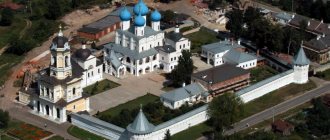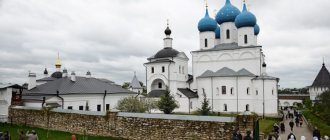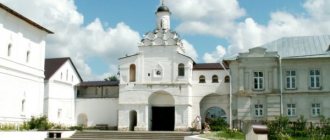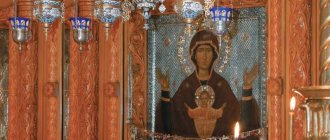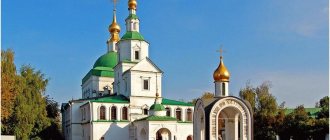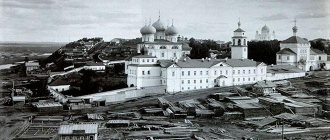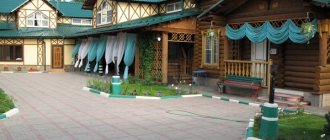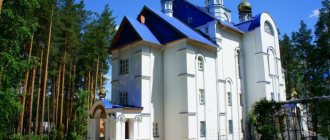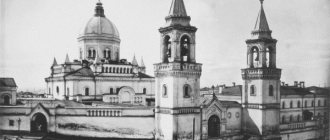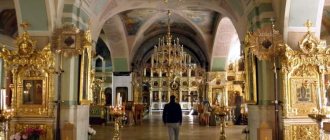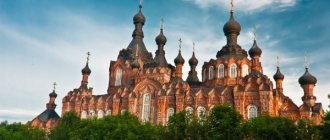In this post I will tell you in detail how to get to the Vysotsky Monastery in Serpukhov, where services are held daily before the miraculous icon of the Most Holy Theotokos. The Inexhaustible Chalice is the last hope of alcoholics and drug addicts who want to get rid of their fatal illness.
I will briefly tell you the history of the monastery, from its foundation to the present day. I will tell you how the monastery miraculously survived during the period of power of atheists - Satanists, and I will introduce you to the daily schedule of monastic services. And so they began:
Schedule of Divine Services at the Vysotsky Monastery in Serpukhov
Worship services on weekdays
- Morning prayers. Midnight Office. Matins 6:00
- Confession. Watch. Liturgy 8:00
- At the end of the Liturgy, a memorial service and custom prayers are served.
- Vespers. Ordinary Akathist 17:00
Divine services on Sundays and holidays
- Confession. Watch. Liturgy 8-00
At the end of the Liturgy, a prayer service for water is performed before the miraculous icon of the Mother of God “The Inexhaustible Chalice”
- All-night Vigil, on the eve of Sundays and holidays
days 17:00
- On Friday a fraternal prayer service with Akathist is served to St. Athanasius Vysotsky (the Younger) 17-45
- On Sunday a fraternal prayer service with Akathist is performed before
miraculous icon of the Mother of God “Inexhaustible Chalice” 17-45
What is the most convenient way to get to the Vysotsky Monastery in Serpukhov on your own?
You can get there on your own from Moscow by train from Kursky Station, the ticket price today is 286 rubles, it takes about two hours. Buses go from the Serpukhov railway station towards the Vysotsky Monastery: No. 8, No. 3, No. 20
Buses take about fifteen minutes. twenty to the “School” stop, get off, walk about thirty meters back and go right along Sverdlova Street. The price of travel on a city bus, if you pay in cash, is 58 rubles.
If you plan to live in Serpukhov and pray to God, buy a transport card; using it to travel around the city by bus costs 38 rubles.
Vysotsky Monastery in Serpukhov
There is also a minibus running from the railway station called “Vysotsky Monastery”. You can simplify your trip by taking a simple taxi from the station; the price to the monastery will be about one hundred and seventy rubles.
You can also get from Moscow to Serpukhov by intercity bus from the Lesoparkovaya metro station, exit to the bus station. Take bus N 458, it takes about two hours, buses leave from the bus station every twenty minutes. Ticket to Serpukhov from 308 rubles.
I repeat. You get to the Serpukhov railway station, from the Serpukhov railway station towards the Vysotsky Monastery there are buses: No. 8, No. 3, No. 20 to the Shkola stop, from there along Sverdlova Street one and a half kilometers to the monastery.
Also from the railway station there is a minibus “Vysotsky Monastery”. In my opinion, it’s easier to take a taxi from the station for 170 rubles and calmly get to the walls of the monastery.
Vysotsky Monastery
Location of the Serpukhov Vysotsky Monastery
The Serpukhov Vysotsky Monastery is located on a high hill on the banks of the Nara River, hence the name Vysotsky. This monastery is one of nine founded by Sergius of Radonezh.
In 1374, the appanage prince Vladimir, a cousin of the Grand Duke Dmitry Donskoy, nicknamed the Brave for the courage and bravery shown in the battle on the Kulikovo Field, received control of the city of Serpukhov.
He decided to found a monastery and fortress here, with powerful walls and towers. So that in times of peace the laity would be strengthened in the Spirit by prayer, and during the invasion of the adversary they would take refuge within the walls of the monastery.
Serpukhov, the southern border of the Moscow region and was often subject to raids by Horde and steppe inhabitants. For a blessing for the construction of a fortress - a monastery, Prince Vladimir turned to his spiritual mentor, St. Sergius of Radonezh.
The inexhaustible cup of Serpukhov
And so the Monk Sergius comes from his monastery to the city of Serpukhov, about two hundred kilometers through dense forests, taking with him his closest disciple, the Monk Athanasius.
Together with Prince Vladimir Andreevich, they go around the outskirts of the city and the monk chooses this place as God-pleasing for the creation of a monastery, then returns back to his monastery, and in Serpukhov leaves his student, the Monk Afanasy, who becomes the first abbot of the Vysotsk monastery.
Rev. Afanasy Vysotsky Sr.
The first forty years of the monastery’s life became the most precious page; during this time the monastery was ruled by abbots who were later glorified among the host of Radonezh Saints. Reverend Athanasius of Vysotsky, his disciple Reverend Athanasius the Younger, Reverend Nikita a relative and student of Sergius of Radonezh.
Vysotsky Monastery Serpukhov
The first abbot of the monastery, St. Athanasius Vysotsky, was an elder of high spiritual life; under his leadership, the second abbot of the Holy Trinity Lavra, St. Nikon of Radonezh, tested himself as a novice with the intention of becoming a monk. At the age of thirty, he took monastic vows and became the successor of Sergius of Radonezh as abbess.
Under the guidance of Afanasy Vysotsky, the holy icon painter Andrei Rublev began his monastic path. Saint Athanasius, in addition to his spiritual gifts, gained fame as a learned man, a skilled calligrapher and a good book writer.
In the 14th century, a huge library of theological books, which the Russian Orthodox Church needed, was collected in Byzantium. Rev. Athanasius, with the Blessing of his confessor, leaves for Constantinople and there, until the end of his days, he works on translating Patristic literature from Greek into Russian.
One of his main works was his translation for the Russian Orthodox Church of a single liturgical charter called the Church Eye, which is used in churches and monasteries in Russia to this day. The Vysotsky Monastery became a bridge between the Orthodox cultures of Rus' and Byzantium.
Serpukhov Monastery
Rev. Afanasy Vysotsky Jr.
Athanasius the Younger came to the monastery at the age of twelve, leaving his parental home, having heard that this monastery had strict monastic rules by which he wanted to live.
At twenty-five he becomes abbot of the monastery.
Afanasy Jr. died at the age of 32 from senile exhaustion. He devoted all his spiritual and physical strength to serving God and people. Despite the brevity of his earthly life, he was glorified by the Church as a saint.
Rev. Nikita Vysotsky
The Monk Nikita served in the rank of Hegumen for nineteen years; during his long pious life he labored and illuminated several places in the country with his prayers, which is why he is called the Monk Nikita of Radonezh, Serpukhov, Vysotsky, Borovsky, Kostroma.
Inexhaustible Chalice icon in Serpukhov
He consoled the suffering, helped all the people who came to him, among whom were monks, laymen, noble people, and simple peasants. Under his spiritual guidance, another Russian saint, Paphnutius Borovsky, grew up among many disciples.
How to get there
organizes pilgrimage trips.
Travel from Yoshkar-Ola
Travel from Cheboksary
Travel from Kazan
If you arrive by personal car, it is recommended to park in specially designated areas. If you do not follow this simple rule, there is a risk that your car will be taken by a tow truck. The parking area is small. On holidays it is quite lively here. Therefore, difficulties may arise as to where to park the vehicle.
An amazing place is located at the address: Moscow region, Serpukhov, st. Kaluzhskaya, 5/3. You can get to it by bus from Moscow, on an excursion tour or by train. From Serpukhovsky station to the monastery there are buses numbered No. 8, No. 3, No. 20. Monastery economy
Architecture of the Vysotsky Monastery
The architectural ensemble of the monastery has evolved throughout the history of the monastery. The first building was a wooden ordinary or one-day temple, built in just one day.
In the 14th century in Rus' there was such a tradition, in gratitude to God for his help, it was customary to build small churches, and all residents of the city or village participated in their construction. The work began on the night of the new day, and was supposed to end before sunset.
Typically, such wooden Temples stood for no more than half a century; after the victory on the Kulikovo Field, Prince Vladimir Andreevich, on the site of a wooden church, erected a large stone cathedral in the name of the Conception of the Blessed Virgin Mary by the Holy and Righteous Anna. This Cathedral, partially rebuilt, has survived to this day.
Monastery in Serpukhov
At the same time, the Refectory Church was erected in honor of the Intercession of the Most Holy Theotokos. Today, only part of the foundation remains from the original structure. It acquired its current appearance in the 19th century.
In the sixteenth and seventeenth centuries, the St. Nicholas and Sergius churches, a bell tower with a Temple in the name of the three Ecumenical Hierarchs John Chrysostom, Basil the Great and Gregory the Theologian were built in the monastery.
The monastery enjoyed special patronage from the Naryshkins, whose possessions were located on Serpukhov land. The mother of Emperor Peter I, Tsarina Natalya Kirillovna née Naryshkina, made generous donations to the monastery.
Serpukhov Monastery Inexhaustible Chalice
Post-revolutionary period, years of hard times
During its life, the monastery was repeatedly attacked by enemies and plundered; it was burned on the road to Moscow by the Crimeans, the Tatar-Mongols, and the Poles were deprived of land and property during the reign of Catherine II.
Terrible years came after the 1918 revolution. In the fall of 1918, a regiment of murderers—Latvian riflemen—was stationed on the territory of the monastery. Mass executions begin under the walls of the monastery.
These ghouls did not spare Russian blood, they shot to their hearts, and to this day, mass graves of those bloody times are found on the banks of the Nara.
The fact that mass executions were carried out by Latvians is confirmed by the fact that after a year the NKVD began to carry out executions, everything was documented, time, place, sentence number, all the signatures of the perpetrators.
After the departure of the Latvians, the Bolsheviks turned the monastery into a concentration camp. Later, the temples began to be used as warehouses and dormitories, with a public toilet. The communists installed a toilet in Altar. The fraternal corps was lucky; a library was organized there.
Monastery in Serpukhov
Recent history of the Vysotsky Monastery in Serpukhov
The Serpukhov Monastery was one of the first to be revived in the Moscow region. In 1991, restoration work was headed by Archimandrite Joseph (Balabanov), today he is Metropolitan of Ulan-Ude and Buryat.
In the 80s of the last century, then Archpriest Joseph was the rector of the only church in Serpukhov, Elijah the Prophet. Together with the Temple community, he petitioned for the restoration of the Holy Monastery and took on the seemingly impossible task of restoring the monastery.
The ancient monastery was actually ruins. In 1996, the rector consecrated the Throne and began to serve the Liturgy in the open air, and a Miracle occurred. The monastery began to come to life and be rebuilt.
On the initiative of the rector, the veneration of the miraculous icon of the Mother of God “The Inexhaustible Chalice”, which had fallen into complete oblivion, was resumed.
Where is the icon of the Inexhaustible Chalice located?
Miraculous Icon of the Inexhaustible Chalice
The appearance of this image occurred in Serpukhov at the end of the 19th century. An old man appeared in a dream to a retired soldier from the Tula province, suffering from severe alcoholism, who drank to the point that his legs were paralyzed, and indicated a means of healing.
A sick alcoholic needed to go to the Monastery of the Most Holy Theotokos in Serpukhov and serve a prayer service in front of the Icon of the “Inexhaustible Chalice”. The sick man crawled on all fours to Serpukhov. The closer he came to the goal of his pilgrimage, the healthier his legs became.
He entered the monastery with his own feet, at his request they found an icon, it hung in the bay of the bell tower, a prayer service was served in front of it and the alcoholic was healed, and the icon became known and revered.
Monastery Inexhaustible Chalice Serpukhov
I write in detail about my experience of healing from drunkenness and binges at the Icon of the Inexhaustible Chalice here. A temperance society was formed at the monastery; there were many copies of this icon; to our greatest regret, the Satanist revolution deprived us of these Shrines.
The Bolsheviks carried all the icons to the shore of the Nara and burned them while the International sang, and to consolidate the victory of the evil spirits and make it more fun, they shot several monks near the fire. The bodies were thrown into the fire, near the icons.
Nowadays, through the efforts of Bishop Joseph and the icon painter Alexander Sokolov, a new Image “The Inexhaustible Chalice” was painted in 1992. The icon was consecrated and included in the Orthodox Church calendar and today is an all-Russian shrine.
In the monastery, an akathist is read daily in front of the Icon. people come to the Icon as their last hope; all those who ask through the prayers of the Mother of God receive help. For those who ask, this is an undeniable daily miracle that happens to them. I write about my healing experience here.
Monastery Inexhaustible Chalice Serpukhov
Patronal holidays
Church celebrations include:
- the conception of the Virgin Mary of St. Anne (22.12);
- memory of the Venerable Radonezh S. (18.07);
- Cathedral of Moscow Saints (8.10);
- Cover (14.10);
- honoring the icon “The Inexhaustible Chalice” (18.05);
- Quick Listen Badge Celebration (11/22).
Shrines of the Vysotsky Monastery in the city of Serpukhov
In 1994, the discovery of the relics of St. Afanasy Vysotsky Jr. took place. In the 14th century, a chapel was built over the grave of the saint, then a small church, and at the end of the 19th century, a spacious temple was erected in honor of Saints Sergius of Radonezh and Athanasius of Athos.
During the reign of atheistic Satanists, the church was demolished with the definition of a building of no architectural or historical value.
In our time, work was carried out to determine the burial place and the solemn discovery of the relics of St. Athanasius and their solemn transfer to the Church of the Intercession
Serpukhov Vysotsky Monastery
Today, everyone who suffers can bow and venerate the miracle worker, the mentor of monks, the helper of all those who suffer. They say it helps very well with leg diseases; during his life he himself suffered from very bad legs.
This, of course, is not the only thing in which Saint Athanasius helps, and instructs in spiritual life and in difficult life situations. Today, on the site of the Saint’s grave, there is a chapel with a wooden tombstone.
The monastery has many ancient icons, some of the most revered are the image of St. George the Victorious from the end of the 14th century, a carved icon of St. Nicholas the Wonderworker, an icon of the Mother of God seeking the lost, and a carved wooden head of John the Baptist.
About four hundred particles of the relics of the great Saints of God, glorified from the first centuries of Christianity to the present day, have been collected. Today there are ten inhabitants living in the monastery.
Mentors
The first abbot of the Serpukhov Monastery was Afanasy Vysotsky Sr., then he was replaced by Afanasy the Younger. The monastery flourished under the leadership of two mentors and led a monastic and traditional lifestyle. After the death of the second teacher, they began to worship the heavenly patron of the city. Reverend Nikita was appointed the next rector.
All three of the first teachers of the Vysotsky Monastery are canonized as saints of Radonezh. They are always remembered as something divine and precious. Currently, the mentor of the monastery since 2011 is Bishop Roman Gavrilov.
